Bellingham, WA
Pacific Northwest
October 2023
The Northwest Mushroomers’ Association held their 31st annual Fall mushroom show In late October, the prime collecting time of the year in the Pacific Northwest. This show, hosted at Western Washington University was wonderfully arranged with the mushrooms mostly displayed in their natural substrate - on trees, branches, moss, grasses, forest floor duff and the like. Although no one took a count here, this display appeared quite similar to a previous one which contained about 310 separate species with multiple examples of most. What is remarkable is that all of the specimens were collected in our general locale and most were found in just the few days leading up the show.
|
The Daily Bucket is a nature refuge. We amicably discuss animals, weather, climate, soil, plants, waters and note life’s patterns spinning around us — Phenology!
We invite you to note what you are seeing and experiencing around you in your own part of the world, and to share your observations in the comments below. Nature is Big.
|
What are fungi and mushrooms?
The kingdom of Fungi is one of five (or six) Kingdoms of life on earth along side Plantae, Animalia, Archaebacteria and Protista. There remains ongoing academic controversy over the number of divisions/phyla that should fall under the Kingdom heading, and even if the classification of kingdom should exist at all. The most common grouping today in the US is the five noted here.
The fungi with which we are concerned here consist of nets of tiny fibrous threads called mycelium which in turn are made up of tinier cells called hyphae. These mycelium threads lace through much of the earth’s soil feeding on and decomposing living and dead plant matter. Further, through the mycelium networks, many form symbiotic relationships with plant and tree roots through which they share nutrients. For a bit more on the nature of fungi, see my previous Bucket.
This Bucket is concerned with what are called the fruiting bodies or mushrooms of the mycelium web. These bodies (mushrooms) come in a myriad of forms, shapes, sizes
 An array of mushrooms as displayed at the show. Enlarge
An array of mushrooms as displayed at the show. Enlarge
and colors. When the time is right, (temperature, moisture, nutrition), for a given species they will pop up from their mycelial substrate and form the mushroom characteristic of their species as dictated by its DNA. The term mushroom however, seems to defy precise or an agreed upon definition. All mushrooms are fungi but not all fungi are mushrooms. So as one expert noted:
We consider a mushroom to be anything that a mushroom-hunter might pick, thus including a wide variety of objects of different sizes, shapes and colors...
Steve Trudell & Joe Ammirati, (2009) Mushrooms of the Pacific Northwest.
Are they Safe to Eat?
The vast majority of the estimated 2 to 3 million species of fungi (only ~ 155,000 have been identified) are harmless. In total, there are only about 100 species that are toxic and NIH reports that there are about 6,000 ingestions of toxic mushrooms in the US each year. Some wild mushroom toxicities are specific to certain individuals as are allergies and yet others adversely affect most of those who eat too much or eat them along with drinking alcohol. Yet there are others that can adversely affect many people if they are not cooked sufficiently as the cooking heat deactivates some toxins. The adverse affects range from mild stomach upset all the way to liver or kidney failure, especially if the person has some pre-existing kidney or liver disease. I will point some of the poisonous or toxic mushrooms that are regularly encountered.
And there other medical conditions that are brought on by various forms of fungal/yeast contaminants such as Ringworm, Candida, nail infections and a variety of conditions caused by molds, and yeasts which I won’t consider here.
The Mushroom Show
 Part of the array of mushrooms laid out by common characteristics. The sign on the table notes that these are gilled mushrooms with pink to salmon spores. Enlarge: Credit Lisa K
Part of the array of mushrooms laid out by common characteristics. The sign on the table notes that these are gilled mushrooms with pink to salmon spores. Enlarge: Credit Lisa K
Among the many hundreds of mushrooms at the show, I have selected a few species to illustrate and to comment on their unique and often interesting forms and characteristics. I will present them in very broad categories of those with gills, and those with pores. In a second bucket I will present a variety of other types of fungi that have rather different appearances.
Gilled Mushrooms
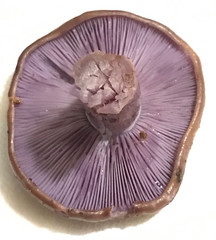 Purple gills illustrated on this Blewet. Credit: RonK
Purple gills illustrated on this Blewet. Credit: RonK
Let’s start with those with gills under their cap. These mushrooms grow and store their reproductive spores in the gills. Even though they all have gills or gill-like structures, they are diverse in shape and color and cut across many different families and genera. The gills are shown in the adjacent sample.
The reproductive spores are released into the environment when mature and are often observable on the ground or on other mushrooms under them. Spores vary in color, size and shape which can be determined for another identification cue. One can see the spores from a spore print which is easily obtained by turning the cap gill-side down on a piece of paper for a few hours. The gills will release pores and show up on the paper in a pattern of the gills displaying their color.
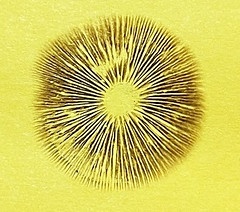 A brown/rusty spore print from “the Funeral Bell” mushroom (Galerina marginata). As its common name implies, it is very toxic.
A brown/rusty spore print from “the Funeral Bell” mushroom (Galerina marginata). As its common name implies, it is very toxic.
Russulas: The Genus Russula, (common name “Brittle gill”) is prevalent here as in many parts of the world. Their common name is based on the fact that they are indeed brittle. If you throw one against a tree for example, it will shatter like glass.
Some Russulas are edible although a few like Russula emetica, will give you stomach difficulties.
Two trays of Russulas were shown at the Show,
 A group of Russulas, many with magenta or purple caps. It is often difficult to determine the exact species as the colors are similar. Some smell fishy and are referred to as seafood Russulas, etc.
A group of Russulas, many with magenta or purple caps. It is often difficult to determine the exact species as the colors are similar. Some smell fishy and are referred to as seafood Russulas, etc.
one displayed some of the bright colored caps that characterized many of these.
The second tray shows one that is a bit of an outlier: The Russula brevipes, in the upper left corner of the second tray shown below is considered edible but rather bland. It is quite fleshy white and larger than others in the genus. However, this mushroom is sometimes attacked and essentially taken over by another fungus, which changes its color to a bright orange. This parasitic fungus changes the bland mushroom into one that is considered quite editable. It then is called “The Lobster,” as it has a fishy taste to it. See below.
 Here are some more Russulas and they seem larger that the previous ones, particularly the one at the top left. this one, Russula brevipes, is large and quite meaty. While edible, it is not very tasty unless it gets infected with Hypomyces lactifluorum, a fungal parasite that changes its whole character. embiggen
Here are some more Russulas and they seem larger that the previous ones, particularly the one at the top left. this one, Russula brevipes, is large and quite meaty. While edible, it is not very tasty unless it gets infected with Hypomyces lactifluorum, a fungal parasite that changes its whole character. embiggen
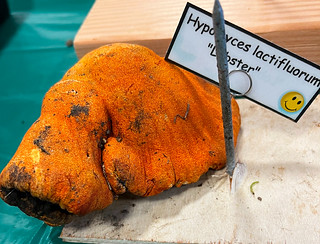 This critter began life as a Russula brevipes as shown in the above photo but was infected and taken over by the parasitic fungus, Hypomyces lactifluorum which converts it into a rather tasty seafoodish treat, called ”The Lobster.” The smiley face on the name card says it is a good edible.
This critter began life as a Russula brevipes as shown in the above photo but was infected and taken over by the parasitic fungus, Hypomyces lactifluorum which converts it into a rather tasty seafoodish treat, called ”The Lobster.” The smiley face on the name card says it is a good edible.
Chanterelles are typically classified as “Choice” edibles and relatively easily identifiable, although there are “false chanterelles” that one needs to be on the lookout for while foraging.
The first identifying characteristic of the true chanterelles is that they appear funnel or
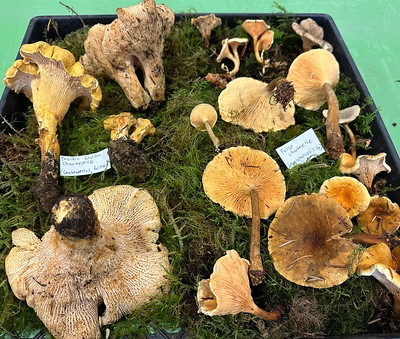 Several species of Chanterelles with Golden or Pacific species shown in the upper left corner, next to the white Chanterelle. Credit Lisa K
Several species of Chanterelles with Golden or Pacific species shown in the upper left corner, next to the white Chanterelle. Credit Lisa K
trumpet-like as shown in the adjacent photo. Secondly you look under the flare at what looks like gills running from lip down the stem. These folds are not separate from the cap or the stem and technically not gills although they function similarly.
There are variants of these mushrooms as well as a number of look-alikes, some of which are toxic. Around here the Golden Chanterelles predominate as shown here in the tray.
 More Cantherelles and related species and look-alikes. Some of these are actually edible and tasty they say such as the “Pig’s Ear” at the bottom although its sign is a caution sign as some people might not take it well. The green face on Turbinellus floccosus, A cantherellus look-alike says it’ll make you sick. Credit: Ronk.
More Cantherelles and related species and look-alikes. Some of these are actually edible and tasty they say such as the “Pig’s Ear” at the bottom although its sign is a caution sign as some people might not take it well. The green face on Turbinellus floccosus, A cantherellus look-alike says it’ll make you sick. Credit: Ronk.
Laccaria laccata is an interesting genus that comes in several colors.
 The Deceivers. Be cautious if eating.
The Deceivers. Be cautious if eating.
They are often called“ Deceivers” as their cap from the top side is not particularly interesting while its gill underneath will be colorful. The one shown here of species laccata is orangish and pink when younger. Another species Laccaria amethysteo — occidentalis looks similar but has very attractive amethyst colored gills and is called the amethyst deceiver.
The European variant of this species is known to accumulate and hold large loads of arsenic, and are best avoided.
 Agaricus species with some highly edible (the Prince) and others not so much (A. dierdorfensis) Click to Enlarge
Agaricus species with some highly edible (the Prince) and others not so much (A. dierdorfensis) Click to Enlarge
Agaricus is another widespread gilled genus in the PNW encompassing some great and not-so-great species. In the photo at the right is a tray of various species of the genus Agaricus where you will see one large mushroom labeled Agaricus agustus: “The Prince.” And truly it is a prince among the top culinary mushrooms. A real prize.
In the upper left corner is a similar looking Agaricus but you can’t read its tag. It is shown below up closer. This is Agaricus buckmacadooii, a non-edible species that while not deadly, can make one sick. The other notable feature of this mushroom is that the person it is named after is in the next photo.
 He is the guy in the black sweater across the room bending over the table. Guess his name.
He is the guy in the black sweater across the room bending over the table. Guess his name.
Amanita has many attractive species such as the most prominent of its species, Amanita
muscaria that has the red cap with the white splotches on it. I expect many of us have seen pictures of these with an elf, fairy or dwarf sitting on top as they are found in forests. Probably among all other mushrooms this one is the prototype of what many call a “Toad Stool”.
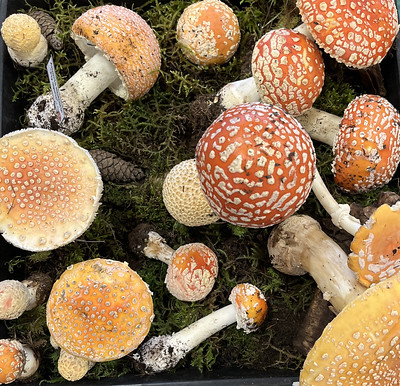 Amanita muscaria at various stages of development and with color variations. They all have to white blobs on their cap. toxic.
Amanita muscaria at various stages of development and with color variations. They all have to white blobs on their cap. toxic.
These mushrooms are toxic as they will make one good and sick and can be fatal for some if eaten in quantity. They also have hallucinogenic properties and are rumored to have been used historically for trips or religious experiences among our ancestors. A. muscaria and some others in the genus derive their psychoactive properties from several alkaloids: muscarine, ibotenic acid and muscimol. There are better ways to trip out.
A. muscaria’s common name is “fly agaric” which goes back to a common use of this mushroom. Historically, it would be broken up and placed in a saucer of milk to catch flies that would eat the mushroom flesh and either die from it or become disoriented and fall in the milk and drown. This attractive toad stool has a long and illustrious history in folk lore as illustrated in this photo.
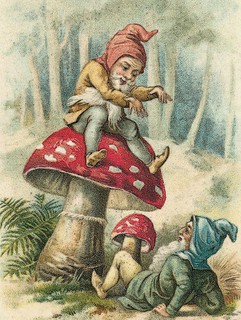 The A. muscaria has been the prototype of mushrooms and an integral part of folk lore for eons involving fairies, elves, dwarves, and other little people of the forest. This is perhaps due to its “magical” properties. (free Photo from www.needpix.com/)
The A. muscaria has been the prototype of mushrooms and an integral part of folk lore for eons involving fairies, elves, dwarves, and other little people of the forest. This is perhaps due to its “magical” properties. (free Photo from www.needpix.com/)
Pored mushrooms: Boletes, Suillus & Xerocomellus
These three genera of mushrooms look quite similar and all belong to the order Boletales. As with so many mushroom classifications today, the DNA analyses have continued to find relationships not previous known or even expected and hence changes in classifications of these mushrooms.
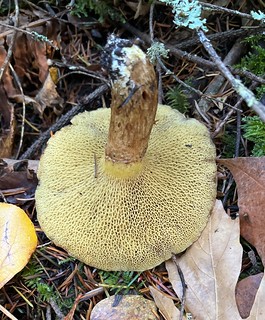
One characteristic of most mushrooms in these genera is that rather than storing their spores in gills, they have sponge-like structures under the cap that consists of tubes that hold the spores. See the spongy looking pores in the sample at the right.
 Here are some of the most common boletes including Boletus edulis or “King Bolete” considered among the most edible of mushrooms. In Europe, this mushroom is called by several names including “Porcini” Here it is most often found dried in grocery stores and used in soups.
Here are some of the most common boletes including Boletus edulis or “King Bolete” considered among the most edible of mushrooms. In Europe, this mushroom is called by several names including “Porcini” Here it is most often found dried in grocery stores and used in soups.
Below is another group of pored mushrooms belonging to the genera Xerocomellus and Suillus. Here you can see the spongy pore structure under the cap that is characteristic of these mushrooms.
 Here are several other members of this pored group including the Suillus. Note in the upper left corner is one referred to as a “Jack” also called “slippery Jack” as its cap is typically slimy. This genus also has two other slippery variants: the “Slippery Jill,” and the “Slippery Cow” not shown here. And then there is “Fat Jack,” which is not slippery at all. These “jacks” are considered edible although they are not prime or choice eating. The Xerocomellus species on the right side are also considered edible but their pore structures get quite mushy as you can see under the Zeller’s bolete. This is best scraped out before cooking. Enlarge
Here are several other members of this pored group including the Suillus. Note in the upper left corner is one referred to as a “Jack” also called “slippery Jack” as its cap is typically slimy. This genus also has two other slippery variants: the “Slippery Jill,” and the “Slippery Cow” not shown here. And then there is “Fat Jack,” which is not slippery at all. These “jacks” are considered edible although they are not prime or choice eating. The Xerocomellus species on the right side are also considered edible but their pore structures get quite mushy as you can see under the Zeller’s bolete. This is best scraped out before cooking. Enlarge
I will end this bucket here so as not to carry on too long. As there are many more mushrooms from the show, I will do a second Bucket to illustrate more of the wide variety of shapes and forms including some that most people might not consider to be mushrooms. However, they are all fungi and therefore related at various levels of taxonomy.
I’ll leave you with a sample of one I just found the other day. I’ll talk about this one and its allies from the show in Part 2.
 IDs or guesses are welcome.
IDs or guesses are welcome.
Since Fall is major fungi fruiting time, being outdoor people you have likely run into some of these lately. If so, please share your sightings with us or anything else that you might have stumbled across on your wanderings.


